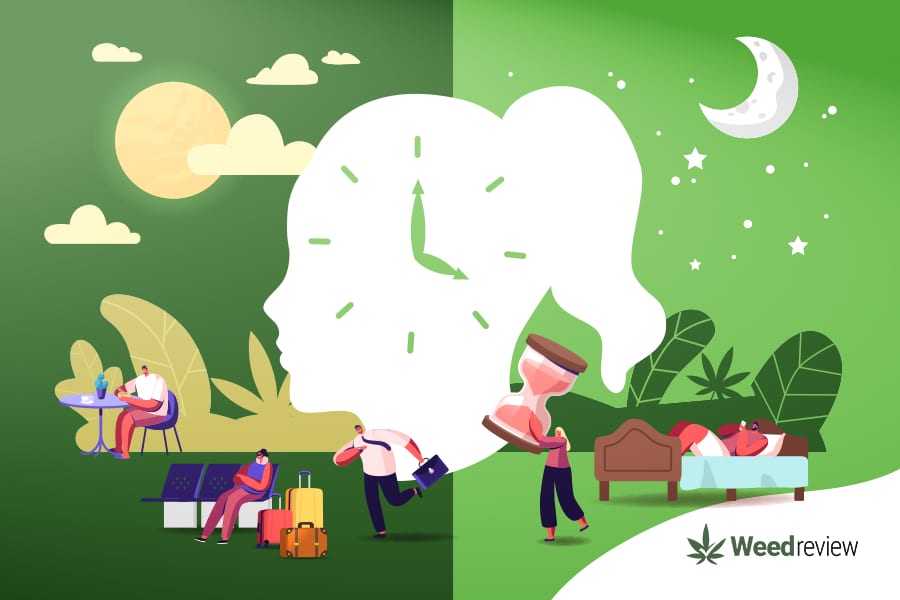
Marijuana & Circadian Rhythms: How Weed Affects the Sleep-Wake Cycle

Table of Contents
As medical cannabis becomes popular, it is crucial to explore the many ways it interacts with our bodies and lives. One fascinating area of focus is the relationship between marijuana and our circadian rhythms, the internal clocks that guide our daily lives.
Understanding how cannabis influences these rhythms can give us better insights into how it affects our sleep.
This article aims to offer a clear picture of how weed influences our biological clocks.
What is circadian rhythm?
Life on Earth is governed by a natural rhythm of day and night, which influences the behaviour of all living beings. In humans, this is called the circadian rhythm, often referred to as our body’s ‘master clock.’ It dictates essential activities like sleeping, eating, and waking up.
The term ‘circadian rhythm’ comes from Latin, combining ‘circa’ (meaning around) and ‘diem’ (meaning day), indicating that it follows an ‘around the day’ pattern.
This biological clock operates on a 24-hour cycle, regulating various bodily processes, including our sleep-wake cycle. By doing so, it ensures that our bodily functions are in sync with the external environment, specifically the natural day-night cycle.
The master clock and the sleep-wake cycle
The circadian rhythm is regulated by a part of your brain called the suprachiasmatic nucleus, or SCN. It is the pacemaker for the master clock.
The SCN receives light signals from our environment, which serve as a primary “zeitgeber” or time-giver. During daylight hours, these light signals prompt the SCN to signal other parts of your brain to release hormones like cortisol, which keep you awake and alert. When darkness falls, the SCN sends signals to release melatonin, a hormone that promotes sleepiness.
The SCN makes sure that all the clocks in our body are synchronised and match the day-night cycle outside. This teamwork helps us prepare for daily changes and stay healthy.
Circadian entrainment: Syncing with the environment
Now, you might be wondering how your body adapts when you travel to a different time zone or when daylight savings changes occur. This is where ‘circadian entrainment’ comes into play. It refers to the process where your circadian rhythm adjusts to environmental changes, such as light and temperature variations.
For example, if you travel to a place where it gets dark later than what you’re used to, your SCN picks up these changes in light and gradually adjusts your sleep-wake cycle to align with the new environment. It’s like resetting your master clock.
This allows us to adapt to changes in day and night cycles, demonstrating the powerful role zeitgebers play in our circadian rhythm.
Cannabis and circadian rhythms: A scientific deep dive
Cannabis has been used for its medicinal and psychoactive properties for centuries. Central to its effects is a group of compounds known as cannabinoids.
The most well-known among these are delta-9-tetrahydrocannabinol (THC) and cannabidiol (CBD). These compounds interact with our body’s endocannabinoid system, which plays a role in regulating a wide range of functions, including sleep.
Influence of cannabinoids on circadian rhythms

The endocannabinoid system (ECS), which plays a crucial role in maintaining body homeostasis, is closely entangled with circadian processes. There is a bidirectional relationship – both processes affect each other. Interestingly, our ECS itself is cyclic in nature and follows a set rhythm, thus further highlighting the closeness with circadian cycles.
Cannabinoid receptors CB1, which are a part of the ECS, are widely distributed in areas of the brain that regulate circadian rhythms – like the SCN. When cannabinoids like THC or CBD interact with these CB1 receptors, they have the potential to influence the circadian system and impact processes like sleep-wake cycles and other circadian-related functions.
Lauren N Whitehurst and colleagues have done one of the most notable works in this field. In their research paper titled ‘The effects of chronic marijuana use on circadian entrainment,’ it was noted that the circadian rhythms of chronic marijuana users were more finely adjusted than their non-using peers.
This study also highlights the potential of cannabis as a zeitgeber. This can potentially explain why some people benefit from using marijuana to overcome their jet lag.
Additional research trends to mention are:
- THC affects our perception of time and disrupts our internal clocks. It inhibits specific brain cells that use a neurotransmitter called GABA, which is crucial for communication within our SCN. As a result, light-induced changes in our daily rhythm are disturbed. This means weed can make you stay up past your bedtime or put you to sleep way earlier.
- Core body temperature is closely linked to our sleep-wake cycle and regulated by the SCN. In a rat study, chronic THC use for a week reversed their normal temperature patterns compared to untreated rats. Even after stopping THC, their peak body temperatures shifted by about 12 hours, indicating a lasting impact on their natural temperature rhythm.
- A 2019 review study states that cannabinoids can be beneficial for the circadian rhythms of old/ageing people. Careful use of medical cannabis can entrain the circadian clocks of aged people and thus help the easing of certain age-related conditions.
It is worth noting that this field warrants further research with more human studies.
The potential of cannabis as a light-giver/zeitgeber and its influence on circadian rhythms needs to be studied in detail. This also includes looking into the dosages, potency, and frequency of use of medical marijuana within this context.
Marijuana’s interaction with sleep
Sleep is not a uniform state, but instead, it’s composed of several stages. The two main stages are REM (rapid eye movement) sleep and non-REM sleep. Here is what we know:
- Research suggests that cannabis, particularly THC, can influence these stages. Some studies indicate that THC may increase deep sleep stages, which are crucial for physical restoration.
- THC also has been found to affect the way our bodies interact with melatonin, a natural hormone responsible for regulating our sleep-wake cycle.
- Marijuana can also reduce our REM sleep and lead to fewer dreams.
- On the downside, chronic & heavy cannabis use is linked with sleep problems like withdrawal, changes to the sleep cycle, and tolerance.
Given the closeness of our circadian cycle to these sleep processes, it is clear marijuana impacts our circadian clock.
Conclusion
Research shows that cannabis can affect our body’s internal clock, but we’re still learning what this means for our health. For some, cannabis might help with sleep, but it could also disrupt our natural rhythms.
As scientists keep studying this, we’ll learn more about how cannabis impacts our sleep and overall health. More importantly, the findings could pave the way for potential therapeutic applications while also informing us about the potential risks.
This information can help us make smarter choices about using cannabis and find a balance that works for each of us.


